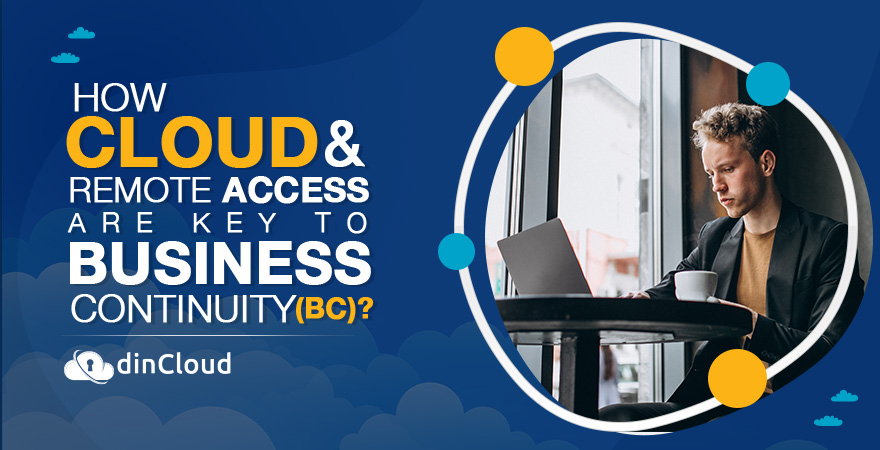In theory, every functional organization envisions a Business Continuity (BC) plan for unforeseen contingencies. However, most such plans fail to attain any tangible shape or mechanism and it’s “business as usual”.

While you may get away with this approach more often than not, when some disruptive event actually rocks an organization, it is only then that such entities realize the mistake they have committed by not converting their BC plan into a reality.
Also Read: Factors that Make Desktop as a Service (DaaS) a Potent Technology
Business Continuity (BC) and Remote Access
Moving forward from the above premise, let’s suppose some disruptive event actually befalls your organization, for which no actual mechanism is still in place. What would be your foremost priority and challenge in such a crisis?
Well, at least the answer to this question is relatively simple. Your top most priority would be to get your mission critical operations up and running, regardless of whether it’s from the workplace or even remotely.
Also Read: Cloud Your Way to Productivity – Wherever You Are!
It has been observed that most of the unforeseen contingencies can render your physical workplace either inaccessible or unusable. In any such situation, the ability of your workforce to remotely access data, processes and enterprise tools is critical.
Therefore, when preparing and implementing any BC plan, the capability of remotely accessing organizational resources is of paramount importance. Now that we have established the baseline for a BC mechanism, let’s dive into the specifics.
Also Read: How to Leverage the Cloud to Optimize Digitization?
Determine User’s Needs
An organization is a combination of many departments or functional areas. Each organizational component has its own unique needs. The first step towards a robust BC and remote accessibility solution is understanding the needs of your users, such as:-
Mission Critical Tasks
You have to outline those mission critical tasks that can jeopardize the core operations of your enterprise. You will have to give full access of these critical tasks to your workforce remotely, by whichever means possible.
Also Read: dinCloud among Leaders in the Booming VDI & DaaS Market
Provision Resources for Critical Tasks
Once you have outlined the mission critical tasks, you will have to delve deep into the specifics of these tasks. Special attention needs to be given to how resource intensive those tasks are, so that you plan your BC resources accordingly.
Also Read: 10 Ways the Cloud Acts as a Driver of Growth
Access to Software and Apps
There is hardly a core organizational process now that does not rely on some specialized enterprise grade software or customized application. Remote access to these resources will have to be part n parcel of your BC solution.
Remote Access to Data
Organizational data serves the dual purpose of being an input as well an output for certain processes. The ability to access mission critical data remotely is very essential for your business continuity (BC) mechanism to be effective.
Also Read: How does the Cloud Ensure Survival and Growth of SMBs?
How the Cloud Fits the BC Profile?
Now that we have outlined the key areas of your BC mechanism, let’s discuss how the cloud is a perfect fit for any such system. We will further focus this discussion on the BC capability of the solutions offered by leading Cloud Service Provider (CSP) dinCloud.
- dinCloud offers Cloud Hosted Virtual Desktops (dinHVD), which can be accessed by users from the workplace, home or any other location.
- Users will be able to access their assigned dinHVDs from multiple devices, regardless of their brand or operating system.
- The advanced packages of dinHVDs have been equipped with multiple, powerful GPUs tailor made to handle processing intensive workloads such as graphics and CAD etc.
- Your dinHVDs can be augmented with fully cloud native productivity tools and enterprise grade applications, with round the clock access.
- Enterprise data, processes and applications are all encapsulated in a unified cloud solution by dinCloud, eliminating the need for on premise infrastructures.
- Organizational data is stored in state of the art dinCloud’s data centers that are certified for the best international standards of privacy and security.
- dinCloud maintains regular backups of your data at physically dispersed data centers across the globe, providing a robust Disaster Recovery (DR).
- The highly interconnected network of global data centers at dinCloud act as a fail safe business continuity (BC) mechanism in unforeseen events.
- dinHVDs are a perfect productivity platform to support a fully remote workforce. Your employees can access tools, data and apps whenever they feel most productive.
- With dinCloud’s solutions, you get Disaster Recovery (DR) and Business Continuity (BC) built into the service, thus saving financial and administrative resources.
Conclusion
When you choose dinCloud for your organizational needs, you no longer have to worry about accessing organizational resources remotely. Rather dinHVDs are custom built for remote access, with DR and BC as part of the overall service.
Contact Us if you have any further queries about how dinCloud’s best in class services deliver a robust business continuity (BC) mechanism.


